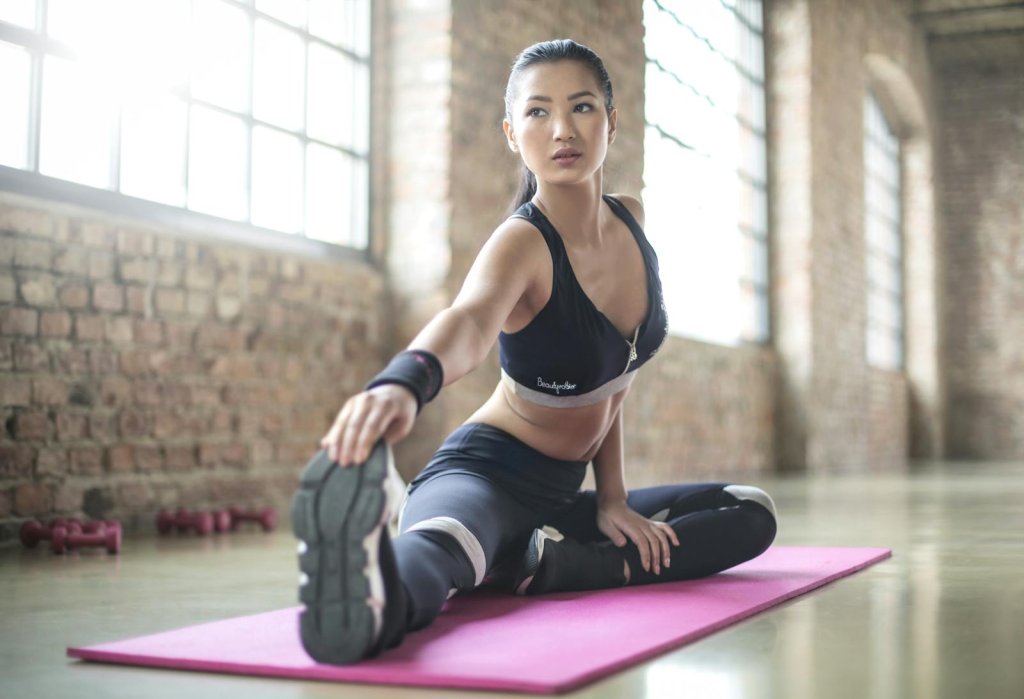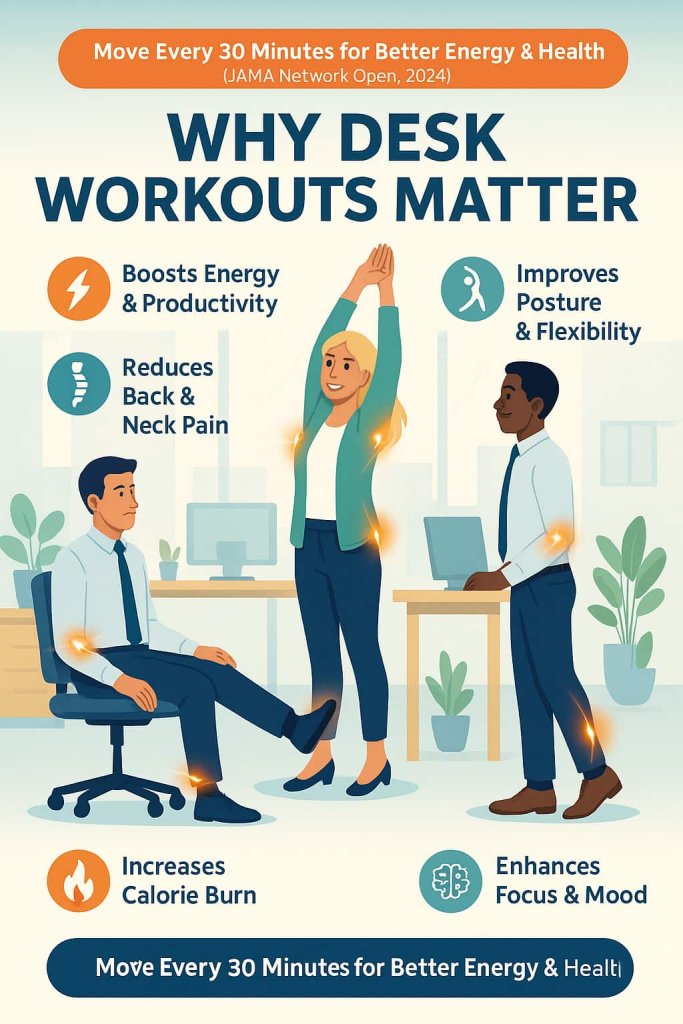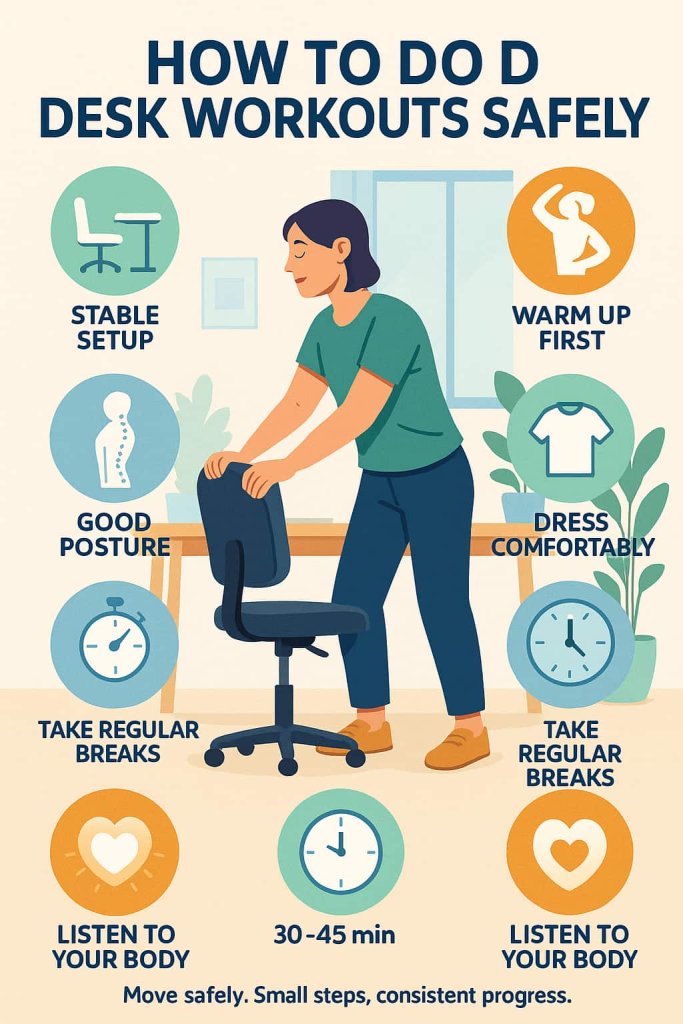Yes — you can get fit right from your desk. Desk workouts help improve posture, burn calories, and reduce the stiffness that comes from sitting for hours. These quick, effective exercises keep your energy levels high and your body strong — no gym required.

Sitting all day increases the risk of heart disease, back pain, and poor circulation. But with the right moves, you can offset those risks and stay productive and pain-free. This guide covers the 20 best desk workouts you can do at work or home, plus research-backed benefits, posture tips, and FAQs.
Why Desk Workouts Matter
Too much sitting weakens muscles, slows metabolism, and leads to poor posture.

According to a 2024 University of Sydney study (published in JAMA Network Open), adults who interrupted sitting every 30 minutes with light movement saw improved glucose control and reduced fatigue compared to those who sat continuously.
Benefits of Desk Workouts:
- Boosts energy and productivity
- Reduces back, neck, and shoulder pain
- Improves posture and flexibility
- Increases calorie burn
- Enhances focus and mood
💡 Tip: Set a reminder to move every 30–45 minutes — even 3–5 minutes of activity counts.
How to Do Desk Workouts Safely
Before you start, make sure your workspace and form are set up correctly to avoid strain and get the most out of each move.

- Use a sturdy setup: Choose a stable, non-rolling chair and clear space around your desk.
- Check your posture: Sit tall, core tight, shoulders relaxed, feet flat.
- Warm up first: Do 2–3 minutes of light stretches or shoulder rolls.
- Move with control: Avoid jerky motions — focus on slow, steady movement.
- Dress comfortably: Wear clothes that let you move freely.
- Take breaks often: Stand or stretch every 30–45 minutes.
- Listen to your body: Stop if you feel pain or dizziness.
Trainer Tip: Start small — even 5 minutes of mindful movement every hour adds up to big results.
20 Best Desk Workouts to Stay Fit While You Sit
Each of these can be done with minimal space or equipment. Mix and match to stay active all day.
1. Seated Leg Raises
Why it works: This simple move fires up your quads and core without leaving your chair. It promotes better blood flow in the lower body, strengthens leg muscles weakened by prolonged sitting, and improves posture stability.
Muscles worked: Quadriceps, hip flexors, lower abs, and core stabilizers.
How to do it:
- Sit upright with your back straight and shoulders relaxed.
- Tighten your abs and extend one leg until it’s parallel to the floor.
- Hold for 5 seconds, then slowly lower it back down.
- Repeat 10–15 times per leg.
Trainer Tip: For a harder version, loop a resistance band around your ankles or wear light ankle weights to increase muscular engagement.
2. Desk Push-Ups
Why it works: A perfect upper-body toner that transforms your sturdy desk into gym equipment. It strengthens your chest, shoulders, and triceps while giving your core a mini-plank challenge.
Muscles worked: Pectorals, triceps, anterior deltoids, core stabilizers.
How to do it:
- Place your palms shoulder-width apart on a solid desk edge.
- Step back until your body forms a straight line from head to heels.
- Bend elbows and lower your chest toward the desk, then press back up.
Trainer Tip: Keep your body tight like a board—avoid letting your hips sag or sticking your butt out. Breathe in as you lower, out as you push.
3. Chair Squats
Why it works: Mimics sitting and standing but strengthens key lower-body muscles, improving mobility, metabolism, and calorie burn.
Muscles worked: Glutes, quadriceps, hamstrings, calves.
How to do it:
- Stand with feet shoulder-width apart in front of your chair.
- Lower your hips slowly as if you’re about to sit down.
- Lightly tap the chair, then press through your heels to rise back up.
Trainer Tip: Keep your chest tall and knees tracking over toes. Don’t collapse into the seat—hover for continuous muscle tension.
4. Seated Torso Twists
Why it works: Loosens up the midsection, relieves stiffness from desk posture, and activates obliques for spinal support.
Muscles worked: Internal and external obliques, lower back, transverse abdominis.
How to do it:
- Sit tall with both feet flat.
- Cross your arms over your chest or place hands behind your head.
- Twist slowly to one side, hold 2 seconds, then rotate to the other.
Trainer Tip: Move gently—no jerking. Keep hips facing forward; motion should come from the ribs and waist.
5. Calf Raises
Why it works: Improves circulation, tones calves, and prevents leg cramps common with sitting.
Muscles worked: Gastrocnemius, soleus, and intrinsic foot muscles.
How to do it:
- Stand behind your chair and hold it for balance.
- Lift your heels to stand on your toes, pause 3 seconds, then lower.
- Perform 15–20 slow reps.
Trainer Tip: For greater effect, perform on one leg at a time or stand on a stair edge to extend range of motion.
6. Desk Dips
Why it works: Firms and strengthens the backs of your arms, which tend to weaken from typing posture.
Muscles worked: Triceps brachii, anterior shoulders, chest assist.
How to do it:
- Sit on the edge of your desk or a stable chair, hands beside your hips.
- Walk your feet forward and slide hips off the edge.
- Lower your body by bending elbows to 90°, then push back up.
Trainer Tip: Keep elbows tucked close and shoulders away from ears. Avoid dipping too deep to protect shoulders.
7. Shoulder Rolls
Why it works: Counteracts hunching by releasing upper-trap tension and improving circulation through the shoulders and neck.
Muscles worked: Trapezius, deltoids, rhomboids.
How to do it:
- Sit or stand tall.
- Roll shoulders upward, backward, and down in a smooth motion for 10 reps.
- Reverse direction.
Trainer Tip: Perform hourly to reset posture and reduce desk-related shoulder strain.
8. Neck Stretches
Why it works: Alleviates tightness from looking at screens all day and reduces risk of tension headaches.
Muscles worked: Sternocleidomastoid, scalenes, upper trapezius.
How to do it:
- Sit upright, shoulders relaxed.
- Tilt your head toward your right shoulder until you feel a gentle stretch.
- Hold 15 seconds, switch sides.
Trainer Tip: Keep movements slow and controlled—avoid rolling your neck in full circles to prevent joint compression.
9. Seated Marching
Why it works: Encourages circulation, boosts heart rate, and activates the core even while seated.
Muscles worked: Hip flexors, lower abs, quadriceps.
How to do it:
- Sit tall with your feet flat.
- Lift one knee toward your chest, lower, and alternate like marching.
- Continue 1–2 minutes.
Trainer Tip: Pump your arms for extra calorie burn and coordination.
10. Wall Sits
Why it works: A static strength move that builds leg endurance and stabilizes the knees and hips.
Muscles worked: Quadriceps, glutes, hamstrings, core assist.
How to do it:
- Stand with your back against a wall.
- Slide down until your thighs are parallel to the floor.
- Hold 20–45 seconds, breathing steadily.
Trainer Tip: Press your back flat against the wall and engage abs to protect your spine.
11. Seated Ab Crunches
Why it works: Strengthens the abdominal wall and supports a stable spine during long sitting hours.
Muscles worked: Rectus abdominis, hip flexors.
How to do it:
- Sit tall, grip chair sides.
- Pull your knees up toward your chest, exhaling as you lift.
- Slowly extend legs back down.
Trainer Tip: Keep your back off the chair for more engagement, and avoid swinging legs.
12. Glute Squeezes
Why it works: Re-engages the glutes, which deactivate during prolonged sitting, and improves lower-body circulation.
Muscles worked: Gluteus maximus, hamstrings.
How to do it:
- Sit up straight with feet flat.
- Tighten your glutes as hard as you can for 5 seconds, then relax.
- Repeat 15–20 times.
Trainer Tip: Do this discreetly during calls—great for toning without anyone noticing!
13. Arm Circles
Why it works: Enhances shoulder joint mobility and posture alignment, preventing stiffness from keyboard use.
Muscles worked: Deltoids, trapezius, biceps assist.
How to do it:
- Extend arms out to the sides at shoulder level.
- Make small circles forward 30 seconds, then backward 30 seconds.
Trainer Tip: Focus on smooth motion and controlled breathing; avoid shrugging shoulders.
14. Seated Side Bends
Why it works: Opens tight sides, stretches obliques, and encourages deeper breathing.
Muscles worked: Obliques, latissimus dorsi, intercostals.
How to do it:
- Sit tall with one hand on the seat, the other reaching overhead.
- Lean gently to the opposite side, keeping chest open.
- Hold 10–15 seconds, repeat both sides.
Trainer Tip: Engage your core to prevent collapsing forward.
15. Ankle Rotations
Why it works: Keeps ankle joints lubricated and reduces swelling from sitting.
Muscles worked: Tibialis anterior, gastrocnemius, soleus.
How to do it:
- Lift one foot slightly off the floor.
- Rotate the ankle clockwise 10 times, then counterclockwise.
- Switch feet.
Trainer Tip: Point and flex your toes after rotations for extra range.
16. Wrist and Finger Stretch
Why it works: Eases tension in the wrists and hands, preventing repetitive-strain injuries like carpal tunnel.
Muscles worked: Forearm flexors and extensors.
How to do it:
- Extend one arm, palm up.
- Gently pull fingers back with your other hand until you feel a stretch.
- Hold 10–15 seconds and switch sides.
Trainer Tip: Shake out hands afterward to restore blood flow.
17. Seated Hamstring Stretch
Why it works: Lengthens tight hamstrings, improving posture and reducing lower-back strain.
Muscles worked: Hamstrings, calves, lower back.
How to do it:
- Sit on the edge of your chair and extend one leg straight.
- Flex your foot and reach toward your toes while keeping your back straight.
- Hold 15–20 seconds.
Trainer Tip: Hinge at the hips rather than rounding your spine for a safer stretch.
18. Standing Side Leg Lifts
Why it works: Strengthens hip abductors for stability, helping correct imbalances from sitting.
Muscles worked: Gluteus medius, abductors, obliques.
How to do it:
- Hold the back of your chair.
- Lift one leg sideways about 12–18 inches, pause, then lower.
- Repeat 10–15 times per leg.
Trainer Tip: Keep your upper body upright—don’t lean to compensate.
19. Standing Hip Circles
Why it works: Promotes hip flexibility, mobility, and balance—key for countering desk stiffness.
Muscles worked: Hip flexors, glutes, obliques, core.
How to do it:
- Place hands on hips, feet shoulder-width apart.
- Slowly rotate hips in a large circle clockwise, then counterclockwise.
- Perform 8–10 each direction.
Trainer Tip: Keep movement smooth and rhythmic, breathing evenly.
20. Mini Jumping Jacks (Desk Version)
Why it works: Quick cardio burst that revives energy, increases heart rate, and breaks sedentary slumps.
Muscles worked: Deltoids, calves, glutes, and core.
How to do it:
- Stand beside your desk.
- Step your right foot out while raising arms overhead, then return to center.
- Repeat to the other side, alternating briskly for 1–2 minutes.
Trainer Tip: Keep movements quiet and controlled—perfect for a quick energy recharge during meetings.
Quick Desk Routine Example (5 Minutes Every Hour)
| Time | Exercise | Duration |
|---|---|---|
| 10:00 AM | Seated Marching | 1 min |
| 10:01 AM | Desk Push-Ups | 1 min |
| 10:02 AM | Seated Torso Twist | 1 min |
| 10:03 AM | Calf Raises | 1 min |
| 10:04 AM | Shoulder Rolls | 1 min |
💡 Repeat every hour to keep your metabolism active all day.
Safety Tips and Posture Essentials
- Keep your feet flat and core engaged.
- Avoid slouching — shoulders relaxed, spine neutral.
- Don’t overdo stretching; stop if you feel pain.
- Stay hydrated and take screen breaks.
FAQs About Desk Workouts
1. How often should I do desk workouts?
Every 30–45 minutes of sitting, take 3–5 minutes to move or stretch.
2. Can desk workouts replace the gym?
They complement — not replace — gym workouts, but they reduce the negative effects of sitting.
3. What equipment do I need?
A sturdy chair and your body weight are enough. Optional: resistance bands or small dumbbells.
4. Are these workouts safe for beginners?
Yes, they’re low-impact and suitable for all fitness levels.
5. Can I do these in formal clothes?
Most moves are discreet and gentle, perfect for office wear.
6. Do desk workouts really burn calories?
Yes — 100 to 200 calories per hour depending on intensity.
7. How do I stay consistent?
Set movement reminders, pair breaks with stretches, or schedule 5-minute sessions hourly.
Conclusion
You don’t need a gym to stay fit — your desk can be your mini fitness station.
Just 5 minutes of desk workouts each hour can boost focus, improve posture, and protect long-term health. Start small, stay consistent, and move often — your body (and boss) will thank you.
References
- WHO Guidelines on Physical Activity & Sedentary Behaviour (2020) — global, evidence-based recommendations to sit less and move more for all adults.
👉 https://www.who.int/publications/i/item/9789240015128 - OSHA Computer Workstations eTool — practical ergonomics checklists and posture setup (chair, monitor, keyboard) to prevent strain before you exercise at your desk.
👉 https://www.osha.gov/etools/computer-workstations - Randomized Crossover Trial: “Dose–Response… Breaking Up Sitting” (MSSE, 2023) — 5 minutes of walking every 30 minutes produced the strongest glycemic benefits during prolonged sitting.
👉 https://pubmed.ncbi.nlm.nih.gov/36728338/ - Micro-breaks Systematic Review & Meta-analysis (2022) — short active breaks significantly improve well-being (vigor/fatigue) and performance, supporting frequent movement breaks.
👉 https://pmc.ncbi.nlm.nih.gov/articles/PMC9432722/ - Harvard T.H. Chan School of Public Health (2025) — up-to-date guidance to sit less, move more; prolonged sitting links to diabetes, heart disease, stroke, and premature death.
👉 https://hsph.harvard.edu/news/make-sitting-less-and-moving-more-a-daily-habit-for-good-health/
